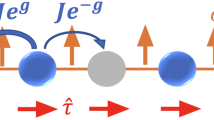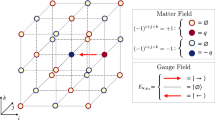Abstract
Lattice gauge theories are used to describe a wide range of phenomena from quark confinement to quantum materials. At finite fermion density, gauge theories are notoriously hard to analyse due to the fermion sign problem. Here, we investigate the Ising gauge theory in 2 + 1 dimensions, a problem of great interest in condensed matter, and show that it is free of the sign problem at arbitrary fermion density. At generic filling, we find that gauge fluctuations mediate pairing, leading to a transition between a deconfined BCS state and a confined BEC. At half-filling, a π-flux phase is generated spontaneously with emergent Dirac fermions. The deconfined Dirac phase, with a vanishing Fermi surface volume, is a non-trivial example of violation of Luttinger’s theorem due to fractionalization. At strong coupling, we find a single continuous transition between the deconfined Dirac phase and the confined BEC, in contrast to the expected split transition.
This is a preview of subscription content, access via your institution
Access options
Access Nature and 54 other Nature Portfolio journals
Get Nature+, our best-value online-access subscription
$29.99 / 30 days
cancel any time
Subscribe to this journal
Receive 12 print issues and online access
$209.00 per year
only $17.42 per issue
Buy this article
- Purchase on Springer Link
- Instant access to full article PDF
Prices may be subject to local taxes which are calculated during checkout
 gauge theory.
gauge theory.





Similar content being viewed by others
References
Kogut, J. B. An introduction to lattice gauge theory and spin systems. Rev. Mod. Phys. 51, 659–713 (1979).
Peskin, M. E. Mandelstam-’t Hooft duality in abelian lattice models. Ann. Phys. 113, 122–152 (1978).
Dasgupta, C. & Halperin, B. I. Phase transition in a lattice model of superconductivity. Phys. Rev. Lett. 47, 1556–1560 (1981).
Fisher, M. P. A. & Lee, D. H. Correspondence between two-dimensional bosons and a bulk superconductor in a magnetic field. Phys. Rev. B 39, 2756–2759 (1989).
Baskaran, G. & Anderson, P. W. Gauge theory of high-temperature superconductors and strongly correlated Fermi systems. Phys. Rev. B 37, 580–583 (1988).
Read, N. & Sachdev, S. Spin-Peierls, valence-bond solid, and Néel ground states of low-dimensional quantum antiferromagnets. Phys. Rev. B 42, 4568–4589 (1990).
Affleck, I. & Marston, J. B. Large-n limit of the Heisenberg–Hubbard model: implications for high-Tc superconductors. Phys. Rev. B 37, 3774–3777 (1988).
Senthil, T. & Fisher, M. P. A. Z2 gauge theory of electron fractionalization in strongly correlated systems. Phys. Rev. B 62, 7850–7881 (2000).
Kivelson, S. A., Rokhsar, D. S. & Sethna, J. P. Topology of the resonating valence-bond state: solitons and high-Tc superconductivity. Phys. Rev. B 35, 8865–8868 (1987).
Moessner, R., Sondhi, S. L. & Fradkin, E. Short-ranged resonating valence bond physics, quantum dimer models, and Ising gauge theories. Phys. Rev. B 65, 024504 (2001).
Balents, L. Spin liquids in frustrated magnets. Nature 464, 199–208 (2010).
Read, N. & Sachdev, S. Large-N expansion for frustrated quantum antiferromagnets. Phys. Rev. Lett. 66, 1773–1776 (1991).
Jalabert, R. A. & Sachdev, S. Spontaneous alignment of frustrated bonds in an anisotropic, three-dimensional Ising model. Phys. Rev. B 44, 686–690 (1991).
Zohar, E., Cirac, J. I. & Reznik, B. Quantum simulations of lattice gauge theories using ultracold atoms in optical lattices. Rep. Prog. Phys. 79, 014401 (2016).
Wegner, F. J. Duality in generalized Ising models and phase transitions without local order parameters. J. Math. Phys. 12, 2259–2272 (1971).
Wen, X.-G. Quantum orders and symmetric spin liquids. Phys. Rev. B 65, 165113 (2002).
Read, N. & Chakraborty, B. Statistics of the excitations of the resonating-valence-bond state. Phys. Rev. B 40, 7133–7140 (1989).
Kitaev, A. & Laumann, C. Exact Methods in Low-dimensional Statistical Physics and Quantum Computing: Lecture Notes of the Les Houches Summer School: Volume 89, July 2008 Vol. 89, 101 (2010).
Fradkin, E. & Shenker, S. H. Phase diagrams of lattice gauge theories with Higgs fields. Phys. Rev. D 19, 3682–3697 (1979).
Hermele, M. et al. Stability of u(1) spin liquids in two dimensions. Phys. Rev. B 70, 214437 (2004).
Nogueira, F. S. & Kleinert, H. Quantum electrodynamics in 2 + 1 dimensions, confinement, and the stability of u(1) spin liquids. Phys. Rev. Lett. 95, 176406 (2005).
Randeria, M. & Taylor, E. Crossover from Bardeen–Cooper–Schrieffer to Bose–Einstein condensation and the unitary Fermi gas. Ann. Rev. Condens. Matter Phys. 5, 209–232 (2014).
Herbut, I. F. Interactions and phase transitions on graphene’s honeycomb lattice. Phys. Rev. Lett. 97, 146401 (2006).
Sachdev, S., Berg, E., Chatterjee, S. & Schattner, Y. Spin density wave order, topological order, and Fermi surface reconstruction. Phys. Rev. B 94, 115147 (2016).
Punk, M., Allais, A. & Sachdev, S. Quantum dimer model for the pseudogap metal. Proc. Natl Acad. Sci. USA 112, 9552–9557 (2015).
Nandkishore, R., Metlitski, M. A. & Senthil, T. Orthogonal metals: the simplest non-Fermi liquids. Phys. Rev. B 86, 045128 (2012).
Moessner, R., Sondhi, S. L. & Fradkin, E. Short-ranged resonating valence bond physics, quantum dimer models, and Ising gauge theories. Phys. Rev. B 65, 024504 (2001).
Zhang, S. Pseudospin symmetry and new collective modes of the Hubbard model. Phys. Rev. Lett. 65, 120–122 (1990).
Auerbach, A. Interacting Electrons and Quantum Magnetism (Springer Science & Business Media, 2012).
Wen, X.-G. Quantum Field Theory of Many-body Systems: From the Origin of Sound to an Origin of Light and Electrons (Oxford University Press on Demand, 2004).
Nelson, D. R. & Kosterlitz, J. M. Universal jump in the superfluid density of two-dimensional superfluids. Phys. Rev. Lett. 39, 1201–1205 (1977).
Lieb, E. H. Flux phase of the half-filled band. Phys. Rev. Lett. 73, 2158–2161 (1994).
Koshino, M., Arimura, Y. & Ando, T. Magnetic field screening and mirroring in graphene. Phys. Rev. Lett. 102, 177203 (2009).
Ludwig, A. W. W., Fisher, M. P. A., Shankar, R. & Grinstein, G. Integer quantum Hall transition: an alternative approach and exact results. Phys. Rev. B 50, 7526–7552 (1994).
Hirsch, J. E. Discrete Hubbard–Stratonovich transformation for fermion lattice models. Phys. Rev. B 28, 4059–4061 (1983).
Chandrasekharan, S. Fermion bag approach to fermion sign problems. Eur. Phys. J. A 49, 90 (2013).
Li, Z.-X., Jiang, Y.-F. & Yao, H. Solving the fermion sign problem in quantum Monte Carlo simulations by Majorana representation. Phys. Rev. B 91, 241117 (2015).
Wang, L., Liu, Y.-H., Iazzi, M., Troyer, M. & Harcos, G. Split orthogonal group: a guiding principle for sign-problem-free fermionic simulations. Phys. Rev. Lett. 115, 250601 (2015).
Schattner, Y., Lederer, S., Kivelson, S. A. & Berg, E. Ising nematic quantum critical point in a metal: a Monte Carlo study. Phys. Rev. X 6, 031028 (2016).
Berg, E., Metlitski, M. A. & Sachdev, S. Sign-problem–free quantum Monte Carlo of the onset of antiferromagnetism in metals. Science 338, 1606–1609 (2012).
Schattner, Y., Gerlach, M. H., Trebst, S. & Berg, E. Competing orders in a nearly antiferromagnetic metal. Phys. Rev. Lett. 117, 097002 (2016).
Li, Z.-X., Wang, F., Yao, H. & Lee, D.-H. What makes the Tc of monolayer FeSe on SrTiO3 so high: a sign-problem-free quantum Monte Carlo study. Sci. Bull. 61, 925–930 (2016).
Dumitrescu, P. T., Serbyn, M., Scalettar, R. T. & Vishwanath, A. Superconductivity and nematic fluctuations in a model of doped FeSe monolayers: determinant quantum Monte Carlo study. Phys. Rev. B 94, 155127 (2016).
Assaad, F. F. & Grover, T. Simple fermionic model of deconfined phases and phase transitions. Phys. Rev. X 6, 041049 (2016).
Pordes, R. et al. The Open Science Grid. J. Phys. 78, 012057 (2007).
Sfiligoi, I. et al. 2009 WRI World Congress on Computer Science and Information Engineering Vol. 2, 428–432 (IEEE, 2009).
Towns, J. et al. XSEDE: accelerating scientific discovery. Comput. Sci. Eng. 16, 62–74 (2014).
Prokof’ev, N. & Svistunov, B. Worm algorithms for classical statistical models. Phys. Rev. Lett. 87, 160601 (2001).
Scalapino, D. J., White, S. R. & Zhang, S. Insulator, metal, or superconductor: the criteria. Phys. Rev. B 47, 7995–8007 (1993).
Acknowledgements
We thank S. Sachdev and T. Senthil for discussions. S.G. was supported by the Simons Investigators Program, the California Institute of Quantum Emulation and the Templeton Foundation. M.R. acknowledges support from NSF DMR-1410364 and the hospitality of the Berkeley CMT Group in Fall 2015. A.V. acknowledges support from the Templeton Foundation and a Simons Investigator Award. Part of this work was performed at the Aspen Center for Physics, which is supported by National Science Foundation grant PHY-1066293. This research was done using resources provided by the Open Science Grid45,46, supported by the NSF, and used the Extreme Science and Engineering Discovery Environment47 (XSEDE), supported by NSF grant ACI-1053575.
Author information
Authors and Affiliations
Contributions
S.G. conceived of and carried out the numerical simulations and data analysis. All authors contributed to the development of the theoretical results and to the writing of the manuscript.
Corresponding author
Ethics declarations
Competing interests
The authors declare no competing financial interests.
Supplementary information
Supplementary information
Supplementary information (PDF 821 kb)
Rights and permissions
About this article
Cite this article
Gazit, S., Randeria, M. & Vishwanath, A. Emergent Dirac fermions and broken symmetries in confined and deconfined phases of Z2 gauge theories. Nature Phys 13, 484–490 (2017). https://doi.org/10.1038/nphys4028
Received:
Accepted:
Published:
Issue Date:
DOI: https://doi.org/10.1038/nphys4028
This article is cited by
-
Roundabout-like defect as a guide of phase-slip lines in a superconducting thin film at low temperature
Emergent Materials (2024)
-
Realistic scheme for quantum simulation of \({{\mathbb{Z}}}_{2}\) lattice gauge theories with dynamical matter in (2 + 1)D
Communications Physics (2023)
-
Non-Hertz-Millis scaling of the antiferromagnetic quantum critical metal via scalable Hybrid Monte Carlo
Nature Communications (2023)
-
Identification of non-Fermi liquid fermionic self-energy from quantum Monte Carlo data
npj Quantum Materials (2020)
-
Circuit-based digital adiabatic quantum simulation and pseudoquantum simulation as new approaches to lattice gauge theory
Journal of High Energy Physics (2020)



